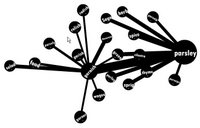
Also, I adore his cartoon art. :-)

Other viral, simple online games: the Free Rice game, Just Curious (answer a question before you can ask one), the ESP game (labelling images).

Also, I adore his cartoon art. :-)

Other viral, simple online games: the Free Rice game, Just Curious (answer a question before you can ask one), the ESP game (labelling images).
Here is one of their graphs, normalized and aligned for when the authors so classified (by them) appeared and their change in sales figures inferred from Amazon rankings.
 They also cite an interesting academic study of whether used book sales cannibalize new book sales on Amazon, which finds they rarely do.
They also cite an interesting academic study of whether used book sales cannibalize new book sales on Amazon, which finds they rarely do.
Why is a bug feeding a gecko? Altruism? Friendship? Some kind of symbiosis not yet understood, most definitely. For those afraid of bugs, this one looks like a piece of tree bark, nothing buggy about it. The gecko is green and attractive. Watch it here on the BBC site.
Remote viewing is a supposed ability to see things from a distance, sometimes as seen by another. It has been reportedly studied by the US military and CIA. Here is an interesting video study purporting to show it working under a controlled circumstance. I find it a bit distracting that the subject who performs the feat is impressed and surprised, too, but it is still fun to watch.
I don't agree on all points -- Some of the design flaws he identifies are tricky "icing" on the consumer cake that it takes a clever designer and a budget to go after: like having a little pocket on the frame back for a remote control. Nice to have, but not mandatory, even for a good consumer experience."We learned deeply a few hard lessons," he said. "Consumer electronics is a very difficult business. It's difficult to get it right." ...
Maybe this particular guy is rightness challenged. Or maybe he meant that getting things right takes time, money and effort, which is true.
But it sounds like he's saying that it's hard to know what's right in product design, and he'll never convince me of that. A ten-year old could have identified the design flaws in the frames I tested this week.
But getting things right does take time, money, and effort; as well as "big-picture" design management of the sort lacking at all but few companies. Someone needs to remember the people you're designing for, and to represent that by stepping backwards out of the details of schedule and bug counts and putting into perspective: "...Hey, can your Grandfather use this for the baby pictures you're sending?" It's the responsible executive's position to make the call to change the schedule to accommodate the experience-breaker issues that will threaten you in a crowded market, and to champion processes like in-home user testing as part of the design cycle.
Kodak, who comes out pretty well for their frame design in his piece, hires interaction designers, although I don't know if they have a Chief Design Officer. So why hire an interaction designer instead of, say, a 10-year old?
 Because most
10 year olds aren't up to arguing with project managers and engineering schedules, and generally keeping their head both in the gritty details and well outside, for that important user perspective.
Because most
10 year olds aren't up to arguing with project managers and engineering schedules, and generally keeping their head both in the gritty details and well outside, for that important user perspective.
Pogue's piece is still good and also funny. As a former TiVo designer mystified by the crapness of most "consumer" electronics design, I especially liked this one:
Question 10: Which is the right way to label the jacks and buttons: White lettering on black (or vice versa), white on white (Momento), or with no text labels at all (eStarling)?
We did think of this at TiVo (of course), but I still wish we had added a little LED flashlight dongle to the back, since there's always bad light at the back of your cabinet!
The saddest part of the article is the alcoholic monkey, though.The results were striking: 43 percent of subjects who had the short genes and who had experienced four or more tumultuous events became clinically depressed. By contrast, only 17 percent of the long-gene people who had endured four or more stressful events wound up depressed—no more than the rate of depression in the general population. People with the short gene who experienced no stressful events fared pretty well too—they also became depressed at the average rate. Clearly, it was the combination of hard knocks and short genes that more than doubled the risk of depression.
... Moffitt and Caspi have found a similar relationship between another gene and antisocial behavior. Abused and neglected children with a gene responsible for low levels of monoamine oxidase in the brain were nine times more likely to engage in violent or other antisocial behavior as adults than were people with the same gene who were not mistreated. Finnish scientists have since found similar effects on genes for novelty seeking—a trait associated with attention deficit hyperactivity disorder. Children who had the genes and who were also raised by strict, emotionally distant parents were much more likely to engage in risky behavior and make impulsive decisions as adults than children with the same genes who were raised in more tolerant and accepting environments.
Jack Houck, a former engineer, hosts "PK" parties in which large groups of people bend ordinary cutlery. He has some instructions and a short video up on his site. His parties are covered in an article with good photos of twisted fork tines at Mind-Energy.com. One of the attendees, Dean Radin, succeeded (and wrote about it) and has even been invited to speak at Google. (Gratuitous connection to the software industry that you didn't expect...!)
Also on Mind-Energy, reader and bender Shannan Rohde posts video, instructions, and photos of himself bending a sad little spoon.
As usual, I wonder why people aren't doing more useful things with this skill. Lack of imagination? Too much crappy cutlery in their lives?
I gave it a half-hearted shot, but haven't succeeded yet. If you do succeed, post me a note? Or if you hear of a PK party nearby, invite me along. Perhaps I lack the right party mood, post-Superbowl!